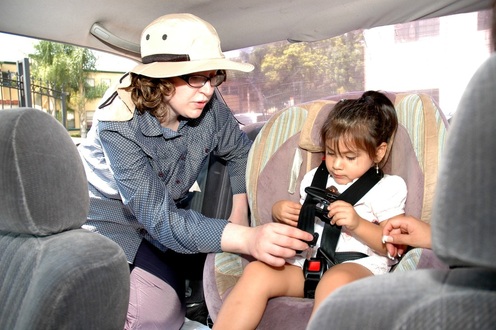LOWER EXTREMITY INJURIES UNCOMMON FOR REAR- FACING CHILDREN
By Judi Lambert
Many parents express concern about their toddler remaining rear-facing to age 2 because it doesn’t look like there is enough room for longer legs. Parents fear that this might put their child at risk for leg injuries in a crash or, at the very least, be ...uncomfortable for their child.
In a recent webinar for CPS Technician-Instructors, Dr. Dennis Durbin, MD, MSCE, lead author of the AAP’s new Policy Statement and Technical Report on Child Passenger Safety and co-scientific director of Center for Injury Research and Prevention at The Children’s Hospital of Philadelphia and Pediatric Emergency Medicine physician, explained that science shows just the opposite to be true. Researchers have found no elevated risk of injury for children ages 12-23 months due to rear-facing restraints. “The second most common crash injury to forward-facing children is lower extremity injuries, behind head injuries,” says Dr. Durbin. “This is caused by the legs flailing in a crash and hitting the interior of the car, usually the back of the vehicle’s front seat.” This particular mechanism of injury is extremely rare for children who are rear-facing because leg movement is better controlled. In fact, Dr. Durbin expects to see a reduction in lower extremity injuries for 12-to 23-month-old children because of the new recommendation. In a study looking at children ages 0-23 months, children in forward-facing seats had a 76% increased risk of injury compared to children in rear-facing seats
Regarding the comfort issue, Dr. Durbin says that children may find it more comfortable to have their legs bent with feet on the vehicle seat than having their legs dangling in a forward-facing position. “Children at this age usually fall asleep in cars, even on short rides. The recumbent rear-facing position is more comfortable and safer. We’ve all seen the position of an upright forward facing child’s head and neck when they are asleep. This would be concerning if a crash were to occur.” Safety seats that can stay rear facing to higher weights also have deeper seats, providing more leg room. CPS Technicians are encouraged to watch the free Webinar for more evidence-based tips on how to explain the new recommendations. Research referenced in this article:B. Henary, CP Sherwood, JR Crandall, RW Kent, F Vaca, KB Arbogast, M Bull. Car Seats for Children: Rear Facing for Best Protection. Injury Prevention. Vol 13(6) . 2007:398-402. Jermakian JS, Locey CM, Haughey LJ, Arbogast KA.. Lower Extremity Injuries in Children Seated in Forward Facing Child Restraint Systems. Traffic Injury Prevention June 2007 ;8(2):171-9
Research referenced in this article:
In a recent webinar for CPS Technician-Instructors, Dr. Dennis Durbin, MD, MSCE, lead author of the AAP’s new Policy Statement and Technical Report on Child Passenger Safety and co-scientific director of Center for Injury Research and Prevention at The Children’s Hospital of Philadelphia and Pediatric Emergency Medicine physician, explained that science shows just the opposite to be true. Researchers have found no elevated risk of injury for children ages 12-23 months due to rear-facing restraints. “The second most common crash injury to forward-facing children is lower extremity injuries, behind head injuries,” says Dr. Durbin. “This is caused by the legs flailing in a crash and hitting the interior of the car, usually the back of the vehicle’s front seat.” This particular mechanism of injury is extremely rare for children who are rear-facing because leg movement is better controlled. In fact, Dr. Durbin expects to see a reduction in lower extremity injuries for 12-to 23-month-old children because of the new recommendation. In a study looking at children ages 0-23 months, children in forward-facing seats had a 76% increased risk of injury compared to children in rear-facing seats
Regarding the comfort issue, Dr. Durbin says that children may find it more comfortable to have their legs bent with feet on the vehicle seat than having their legs dangling in a forward-facing position. “Children at this age usually fall asleep in cars, even on short rides. The recumbent rear-facing position is more comfortable and safer. We’ve all seen the position of an upright forward facing child’s head and neck when they are asleep. This would be concerning if a crash were to occur.” Safety seats that can stay rear facing to higher weights also have deeper seats, providing more leg room. CPS Technicians are encouraged to watch the free Webinar for more evidence-based tips on how to explain the new recommendations. Research referenced in this article:B. Henary, CP Sherwood, JR Crandall, RW Kent, F Vaca, KB Arbogast, M Bull. Car Seats for Children: Rear Facing for Best Protection. Injury Prevention. Vol 13(6) . 2007:398-402. Jermakian JS, Locey CM, Haughey LJ, Arbogast KA.. Lower Extremity Injuries in Children Seated in Forward Facing Child Restraint Systems. Traffic Injury Prevention June 2007 ;8(2):171-9
Research referenced in this article:
- B. Henary, CP Sherwood, JR Crandall, RW Kent, F Vaca, KB Arbogast, M Bull. Car Seats for Children: Rear Facing for Best Protection. Injury Prevention. Vol 13(6) . 2007:398-402.
- Jermakian JS, Locey CM, Haughey LJ, Arbogast KA.. Lower Extremity Injuries in Children Seated in Forward Facing Child Restraint Systems. Traffic Injury Prevention June 2007 ;8(2):171-9
